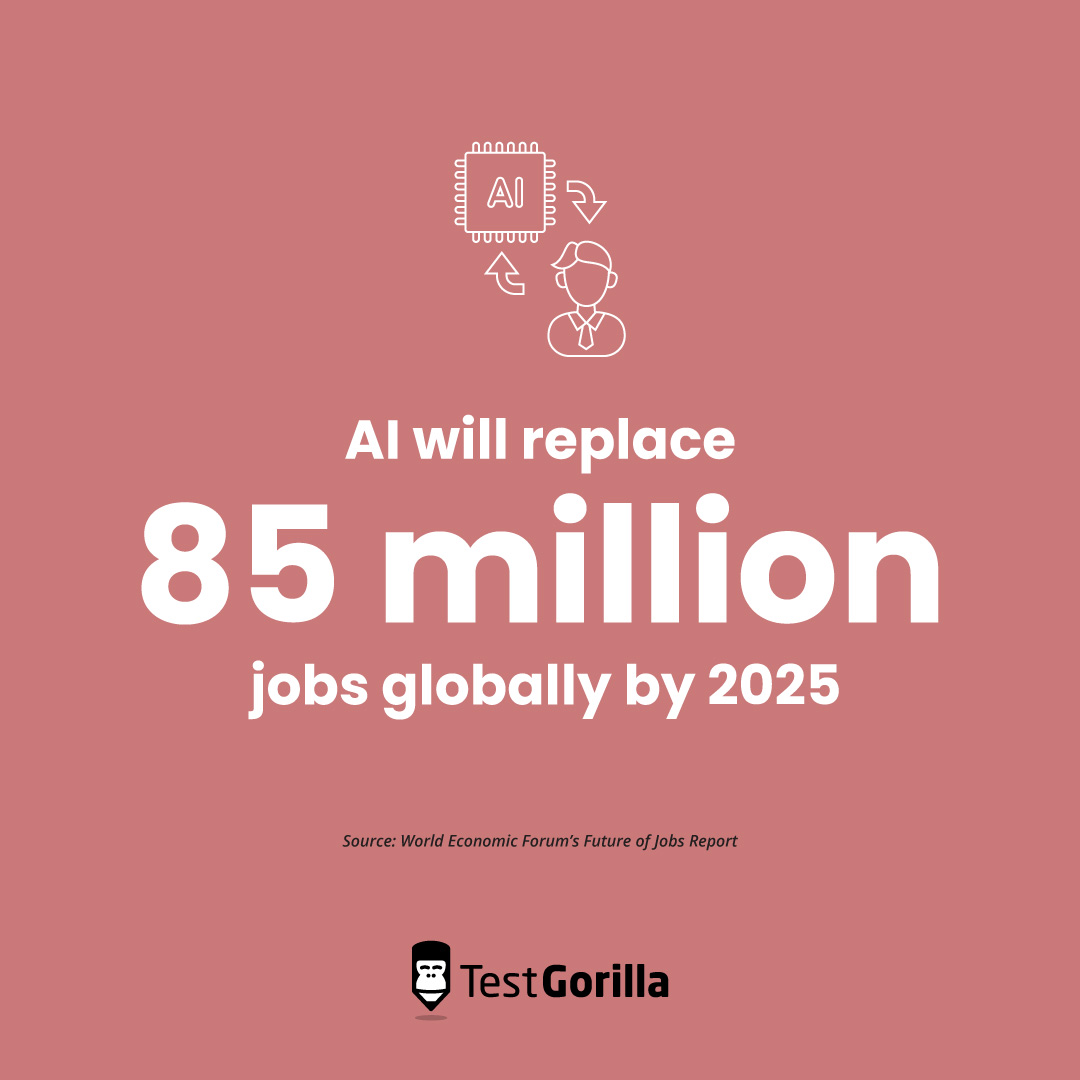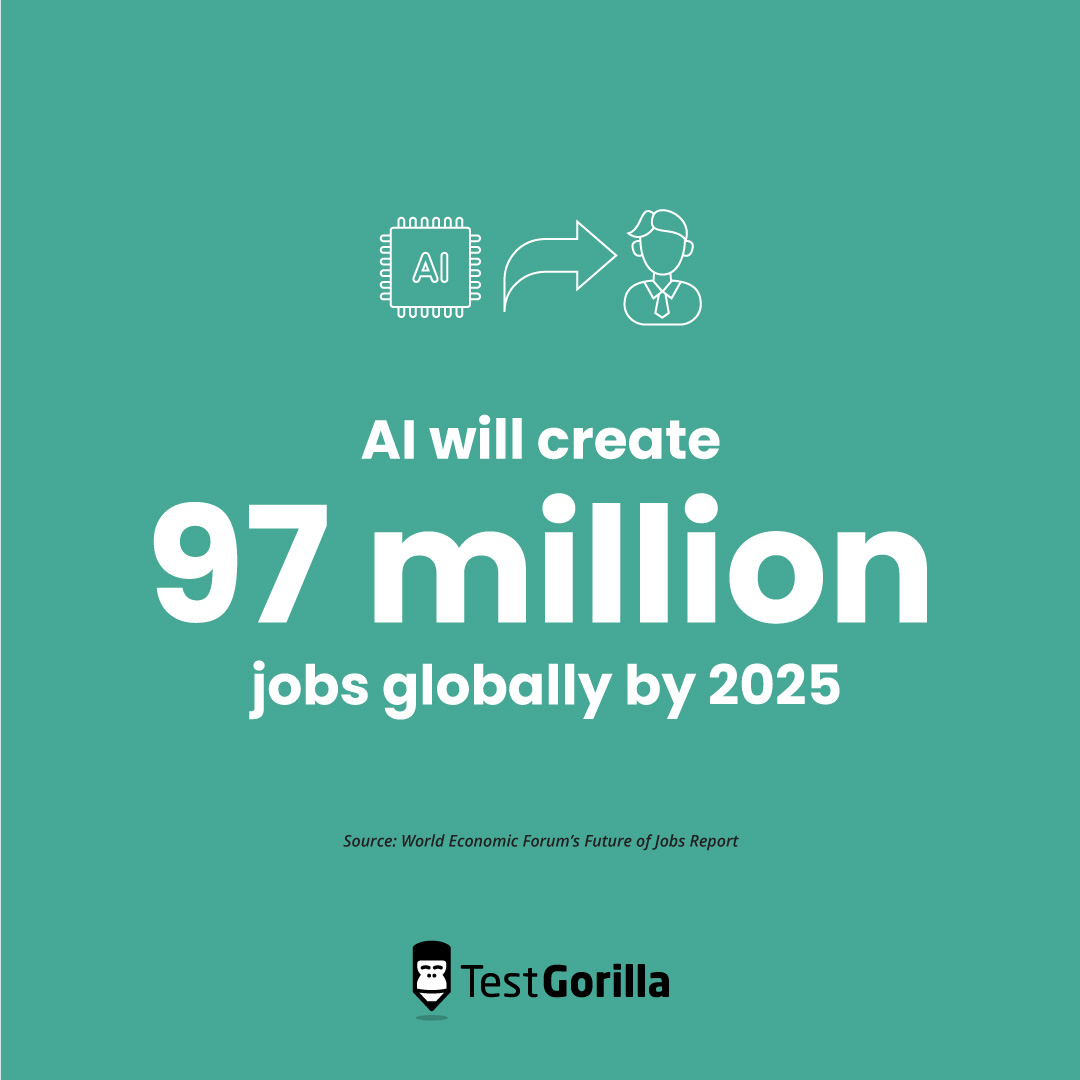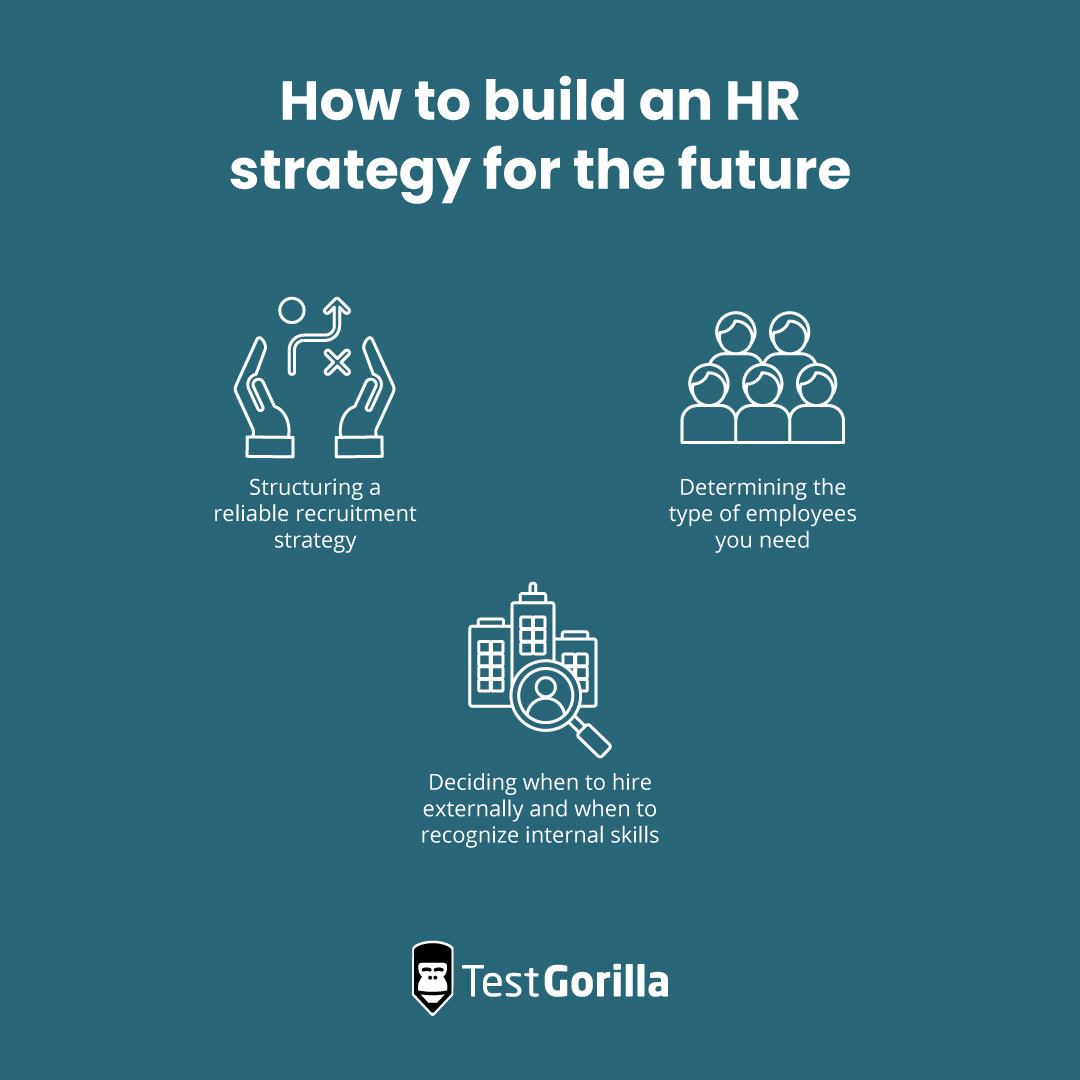The skills an organization needs as the world changes: How to stay ahead of the curve
Skills are shifting and changing at an unprecedented rate due to the rise of AI and the lasting impact of the pandemic. These events have caused massive challenges for HR professionals that require the proper know-how to navigate.
When the skills needed for a job change, it starts a vicious cycle of hiring new people and laying off others with obsolete skills. This is costly and damaging to your brand image.
So, what’s the ideal recruitment strategy to keep your organization agile and workforce stable when skill requirements keep changing?
The best plan of action is assessing an employee’s future potential, upskilling and reskilling where necessary, and focusing on skills over education and experience.
Whether you’re hiring externally or reskilling internally, the key point is to have the right skills inside your organization to succeed in a dynamic environment.
This article discusses how businesses can stay ahead of the curve over the next decade, which skills to focus on when hiring, and how to structure a future-proof recruitment strategy.
The current landscape and the challenges we face
We’re living through a period of unprecedented technological advancements where skills and competencies are becoming outdated at an extraordinary rate.
Here are some of the biggest changes the working world is going through.
Tech advancements and AI
AI language modeling is quickly gaining traction – tools like OpenAI’s ChatGPT are disrupting entire industries with their ability to write, edit, code, and even teach.
According to the World Economic Forum’s Future of Jobs Report, AI will replace 85 million jobs globally by 2025. The same report indicates that AI will also create 97 million new jobs, but those roles may be quite different than those lost.
For example, AI is replacing many jobs that can be automated, such as data entry. But roles that require subtle human skills like problem-solving and communication cannot be replicated by machines.
The rise of technology is forcing workers to rely on transferable skills and make quick and drastic career switches (from one industry or role to a different one), and it’s forcing companies to either use this technology to their advantage or get left behind.
A real-life example of this is UPS, which adopted AI to start creating delivery routes. This saves more than $200m per year in fuel costs, cuts time on manually determining the routes, and opens new opportunities for hiring software engineers and data analysts.
The global skills shortage
The working world is currently in the midst of a dramatic skills shortage due to the Great Reshuffle. Workers are switching from company to company, and because of this, organizations lack the talent and skills they need to function efficiently.
However, even during a talent crisis, some organizations continue to make drastic job cuts.
For example, 41% of all job cuts in January 2023 were in the tech industry, but tech remains one of the industries with the most dire skills shortage.
These statistics don’t necessarily correlate. However, the organization facing a dramatic skills shortage may not be the same organization laying workers off. If you’re planning on following the trend, be wary of your reasoning for layoffs: Are you simply downsizing, or are you reprioritizing for different skills?
The numbers above tell us that firing skilled workers to hire other skilled workers is a recipe for disaster. In that case, it may be better to hold on to the talent you have. Investing in your people and looking internally for skills are crucial tactics during the Great Discontent.
For example, a manager thinks it’s time to let go of their data entry specialist because of changing needs, but this worker might have key transferable skills and potential for upskilling.
It’s well-known that companies want to hold onto existing customers because it’s easier and more affordable than getting new ones, and the same can be said about employees.
Liz Ryan, the founder and chief executive office of Human Workplace, says that it's five to ten times more expensive to replace a valuable employee who leaves than to retain them.
Recovering from the pandemic
Countless roles changed their skill requirements during and after the pandemic, affecting their respective workplaces in big ways.
Here are just a few of the changes that the pandemic brought on:
Most people had to adjust to remote work for the first time
Managers had to learn to coach and monitor distributed teams with brand-new tools
Many workers had to shift their communication skills from in-person to video calls and instant messaging
However, one of the greatest impacts Covid-19 had on work was how it affected physical, blue-collar jobs.
One example is the thousands of food service employees that lost their jobs due to the lockdown.
At the time, there were thousands of customer service call center roles that were unfilled, but the skill requirements are nearly identical to food service, such as communication and problem-solving.
If both the candidates and employers knew they had the potential, we could’ve given people great opportunities and solved a skills shortage at the same time.
These challenges – the rise of AI, the skills shortage, and the lasting impact of the pandemic – may seem daunting, but there are clear solutions to all three:
Creating an agile workforce, identifying roles that allow for transferable skills, hiring candidates who demonstrate these capabilities, and upskilling or reskilling based on your needs.
Let’s talk about this in depth.
The world is changing quickly: The case for hiring for potential
Skills are rapidly changing and becoming obsolete, which is more than a headache for hiring managers.
What’s the solution when your needs keep shifting?
Don’t look for workers that fit your current requirements. Hire for the skills you’ll need and recruit employees with future potential.
Which skills will we need in the future?
If skills are changing so fast, how will we know what skills we’ll need in one year, three years, or five years from now?
According to a Forbes article, these are the top in-demand skills for the next ten years[1]:
Digital literacy
Data literacy
Critical thinking
Emotional intelligence
Creativity and innovative thinking
Collaboration
Flexibility
Leadership skills
Time management
Curiosity and continuous learning
So, what should we do if these skills are different from the ones organizations need now?
Let’s talk about that last skill: curiosity and continuous learning.
The Forbes article states that this ability is the most valuable on the list. A mindset of continuous improvement is the best capability an employee can possess.
This means we should prioritize learning and improvement in our people strategy in two big ways:
Hiring people with the capacity and willingness to learn
Offering upskilling and reskilling opportunities to all employees
We’ll talk about this subject next.
Upskilling and reskilling are a crucial future strategy
Not only should we prepare for immediate changes in a profession, but we should also be prepared for the continuous changes that cascade after that. These disruptions will keep coming faster and faster – no job will remain the same for more than a few years at a time.
All jobs as we know them are going to become temporary, but that doesn’t mean your employees have to be.
When skills are changing so quickly, the solution is hiring people who not only have potential in certain fields but also people who are ready and willing to adapt to change and learn whatever comes at them.
Both of these tactics fall under the umbrella of hiring for potential. When you aren’t sure which skills your organization will need in the future, it’s fundamental to hire for potential.
For more insights on this topic, read our deep dive into hiring for experience vs. hiring for potential.
The question of hiring for experience or potential is similar to the debate of whether to hire for hard skills or soft skills. We believe that you should hire for both, although it’s important to remember that soft skills may be more transferable and adaptable.
Businesses of the future need to put a focus on continuous learning to properly thrive. This means that human resources practices need a complete rehaul, including rethinking the approach to hiring, training, promoting, and talent sharing (but more on that later).
Upskilling and reskilling enable HR professionals to hire for potential and soft skills rather than a candidate’s history.
Relying on degrees and work experience isn’t enough anymore. The world moves too fast. A person might spend years of their life earning a degree that might only hold strict relevance for a few more years. Or, the candidate might have years of experience in a role that has now-obsolete processes.
This means you have to rely on the skills they have or could build instead of a resume full of past events.
Experience can still be valuable, but we believe that you shouldn’t solely rely on it.
The world is dynamic, and we can't put all our stakes on a candidate’s history.
Investing in training is investing in your people, and it’s the most effective way to make your business resilient against change and sudden events.
The best insights on HR and recruitment, delivered to your inbox.
Biweekly updates. No spam. Unsubscribe any time.
How to build an HR strategy for the future
The world is rapidly changing before our eyes, which means you need to develop an adaptable HR strategy. This includes:
Structuring a reliable recruitment strategy
Determining the type of employees you need
Deciding when to hire externally and when to recognize internal skills
Let’s take a look at these three points.
1. How to structure your recruitment strategy
We recommend adopting skills-based hiring to properly prepare your recruitment process for the future.
A skills-based approach enables your workforce to become highly dynamic – it can react quickly to changes in your current business environment much faster than with traditional methods.
But you must be proactive and agile while embracing tech advancements to enable talent strategies, such as skills testing software and job simulation software.
Here’s an example structure of a skills-based recruitment process:
Assess applicants with skills tests
Invite successful candidates to structured interviews
Ask candidates behavioral and situational questions during the structured interview to discover key soft skills and competencies
Evaluate candidates with job simulations or trials
Recruit successful candidates
Continue to train and upskill your workforce
Let’s briefly touch on the two main skills-based hiring methods mentioned here: skills tests and structured interviews.
Skills tests
Talent assessments enable you to verify a candidate's skills objectively and accurately.
They’re able to assess skills, gauge culture and personality, and even uncover transferable skills.
For example, we spoke about hiring a former food service employee for a customer service role. A skills assessment would tell you their proficiency in communication, problem-solving, empathy, and teamwork.
Skills tests are also useful for assessing a candidate’s future potential. Personality tests, for example, help you evaluate adaptability and flexibility, two key power skills that help an employee stay agile in a changing environment.
Structured interviews
A structured interview is a job interview with a clear process and predefined criteria for “passing.” They help bring objectivity to the interview stage, making them more focused on skills than charisma.
Structured interviews aren’t just a key part of a skills-based recruitment process, they’re also proven to be more effective than traditional interviews.
How do structured interviews help you hire for the future?
Structured interviews are key because they dig deep into "how" a person does a job through behavioral and situational questions.
How a person does their job is nearly as important as their skills in a shifting landscape. This is the difference between skills and competencies – skills are what employees do, and competencies tell you how they do it.
For example, if a project management candidate solved a scheduling conflict in a calm, collected manner and communicated the issue clearly to everyone involved, you can be more sure that they’ll approach new challenges in the same way, even if they don’t involve managing schedules.
A structured interview that asks candidates behavioral questions like “Tell me about a time you misunderstood instructions. How did you handle it?” helps dig into how that person deals with a problem.
Skills are crucial, but how a candidate puts them to use is just as important.
2. The type of employees you should hire
What does a “future-proof” employee look like in terms of skills? What kind of employees should you hire?
Here are a few tips:
Focus on candidates that have non-trainable skills, like empathy, a learning mindset, and the right attitude. Most other skills can be taught.
Look for candidates that have a focus on improvement, are hungry for a challenge, and are ready to innovate.
Don’t put emphasis on education and experience – the focus should be on skills and potential.
To succeed in the current landscape, you need to hire highly adaptable workers.
The future requires you to understand an employee’s potential, which means you have to hire like you never have before. You need to recruit a candidate for a role they’ve never done instead of just focusing on what you need right now.
It's also good to consider your skills test benchmarks because you might want to consider a candidate who's a little behind in a few skills because they have the right personality and culture.
You then upskill them in any areas where they need improvement.
3. When to hire externally and when to look internally
It’s tough to determine whether you should seek resources from outside your workforce or train your own people. It requires an in-depth understanding of your company’s skill pool and what you may be missing.
We recommend finding this information by conducting regular skills gap analyses.
This is the process of assessing individuals or teams to find missing skills, often with the use of skills tests.
Once you know where your company has skills gaps, you can make plans to fill them.
Offer your current workforce upskilling and reskilling opportunities for adjacent skills, and for any skills that you can’t fill with training, you can hire externally.
Sometimes you can’t avoid hiring externally, but whenever you can provide internal mobility to your current people, it’s more affordable for the organization and boosts employee satisfaction.
Help your workforce build professional development plans to map out their future career aspirations. These documents help employees organize their goals, lay out the steps to achieve them, and describe the available resources.
But what if your team doesn’t want to upskill? Is the only option hiring externally?
Not necessarily.
Talent sharing is the concept of lending skills from department to department. It nurtures an adaptable work environment and provides your workers with opportunities to grow their network and skills.
This process keeps a company agile and fosters continuous growth. If your team needs a certain skill, you can borrow a worker from another department who’s interested. And in return, if another team needs one of your people, they can lend a hand.
Stay agile in a shifting environment with skills-based hiring
Change can be daunting, but it’s unavoidable in the age we live in.
Rapid technological advancements and a talent shortage can make skills a tricky subject for HR professionals. Which ones do you need? Which ones will you need?
We believe we can tackle this difficult situation by relying on skills-based hiring to objectively discover skills and future potential. Roles may change, but if employees have a learning mindset, they can shift with the role.
To learn more about the agility of skills-based practices, read our article on how skills-based organizations become more adaptable.
If you’d like to assess adaptability and steadiness in your next candidate, try our DISC test in your next pre-employment assessment.
Source
Marr, Bernard. (August 22, 2022). "The Top 10 Most In-Demand Skills For The Next 10 Years". Forbes. Retrieved June 21, 2023. https://www.forbes.com/sites/bernardmarr/2022/08/22/the-top-10-most-in-demand-skills-for-the-next-10-years/
You've scrolled this far
Why not try TestGorilla for free, and see what happens when you put skills first.

















